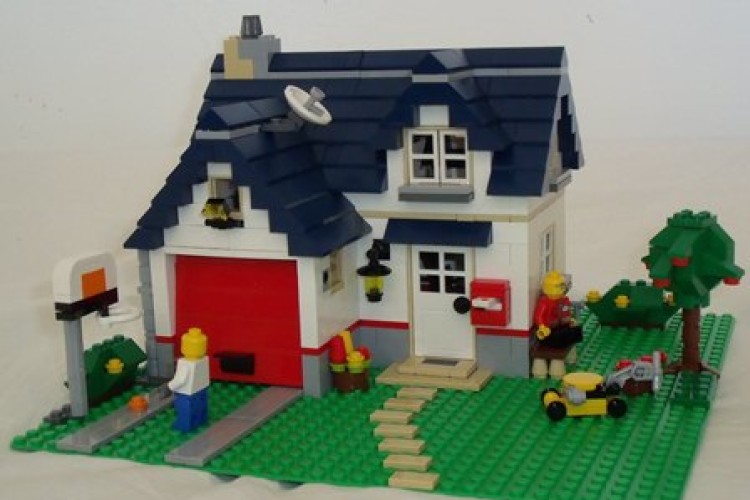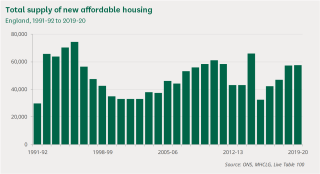The Ministry of Housing said that its funding package would support the construction of around 119,000 new homes by 2026. Of these, 57,000 will be for private ownership, 29,600 for social rent and 6,250 affordable rural homes.
Around 57,600 units of affordable housing units were delivered in 2019-20.
The funding announced today forms the lion’s share of the £11.5bn Affordable Homes Programme 2021-2026.
Nearly 90 new partnerships, made up of councils, housing associations and private providers, have already had bids approved for their share of programme funding. Homes England, the government body responsible for housing delivery, will distribute £5.2bn to 31 partner organisations outside of the capital. The Greater London Authority (GLA) gets £3.4bn.
The mayor of London’s new programme – running alongside the extended 2016-23 programme – will see 79,000 new homes started over the next five years.
Homes England chief executive Peter Denton said: “Not only does today’s announcement give our new strategic partners the funding, flexibility, and confidence they need to build much needed affordable homes across the country, it also establishes a large network of organisations looking to share their skills and capabilities to expand the affordable housing sector and transform communities.
“By forming strategic partnerships with a wide range of public and private organisations, we are creating the conditions needed for institutional investment to catalyse affordable housing supply and in future give local authorities more of the tools they need to plan and act strategically, shaping their communities and building new homes.”
Homes England’s strategic partners are listed below:
| Organisation | Grant funding | Number of homes |
|---|---|---|
| Abri | £250m | 3,218 |
| Accent | £210.2m | 3,305 |
| Aster | £114m | 1,550 |
| Bromford | £239.9m | 4,000 |
| Clarion | £249.7m | 4,770 |
| Curo & Swan | £160.4m | 2,425 |
| EMH & Midland Heart | £171.7m | 3,551 |
| Flagship | £93m | 1,500 |
| Great Places | £240.8m | 4,920 |
| Greensquare Accord | £212.9m | 3,755 |
| Guinness & Stonewater | £250m | 4,180 |
| Hyde | £250m | 3,000 |
| Karbon | £131.5m | 2,200 |
| Legal & General | £125.5m | 2,121 |
| LiveWest | £123.6m | 2,550 |
| Longhurst & NCHA | £230m | 3,935 |
| McCarthy and Stone | £93.9m | 1,500 |
| Metropolitan Thames Valley | £62.6m | 1,500 |
| Onward | £152.4m | 3,208 |
| Orbit | £103.9m | 1,500 |
| Places for People | £250m | 4,403 |
| Platform | £250m | 4,680 |
| Riverside | £80.8m | 1,530 |
| Sage | £73.5m | 1,750 |
| Sanctuary | £99.5m | 2,000 |
| Sovereign | £166.9m | 3,338 |
| Thirteen | £191.3m | 3,270 |
| Together | £249.9m | 4,047 |
| Torus | £140.3m | 2,736 |
| Vistry | £83m | 1,474 |
| Vivid | £105.6m | 1,550 |
What is affordable housing?
There is no agreed definition of affordable housing. The most commonly referred to definition of affordable housing is set out in Annex 2 to the National Planning Policy Framework (NPPF).
That says that affordable housing is housing for sale or rent, for those whose needs are not met by the market (including housing that provides a subsidised route to home ownership and/or is for essential local workers); and which complies with one or more of the following definitions:
a) Affordable housing for rent: meets all of the following conditions: (a) the rent is set in accordance with the government’s rent policy for Social Rent or Affordable Rent, or is at least 20% below local market rents (including service charges where applicable); (b) the landlord is a registered provider, except where it is included as part of a Build to Rent scheme (in which case the landlord need not be a registered provider); and (c) it includes provisions to remain at an affordable price for future eligible households, or for the subsidy to be recycled for alternative affordable housing provision. For Build to Rent schemes affordable housing for rent is expected to be the normal form of affordable housing provision (and, in this context, is known as Affordable Private Rent).
b) Starter homes: is as specified in Sections 2 and 3 of the Housing and Planning Act 2016 and any secondary legislation made under these sections. The definition of a starter home should reflect the meaning set out in statute and any such secondary legislation at the time of plan-preparation or decision-making. Where secondary legislation has the effect of limiting a household’s eligibility to purchase a starter home to those with a particular maximum level of household income, those restrictions should be used.
c) Discounted market sales housing: is that sold at a discount of at least 20% below local market value. Eligibility is determined with regard to local incomes and local house prices. Provisions should be in place to ensure housing remains at a discount for future eligible households.
d) Other affordable routes to home ownership: is housing provided for sale that provides a route to ownership for those who could not achieve home ownership through the market. It includes shared ownership, relevant equity loans, other low cost homes for sale (at a price equivalent to at least 20% below local market value) and rent to buy (which includes a period of intermediate rent). Where public grant funding is provided, there should be provisions for the homes to remain at an affordable price for future eligible households, or for any receipts to be recycled for alternative affordable housing provision, or refunded to government or the relevant authority specified in the funding agreement.
Clear?
Got a story? Email news@theconstructionindex.co.uk




